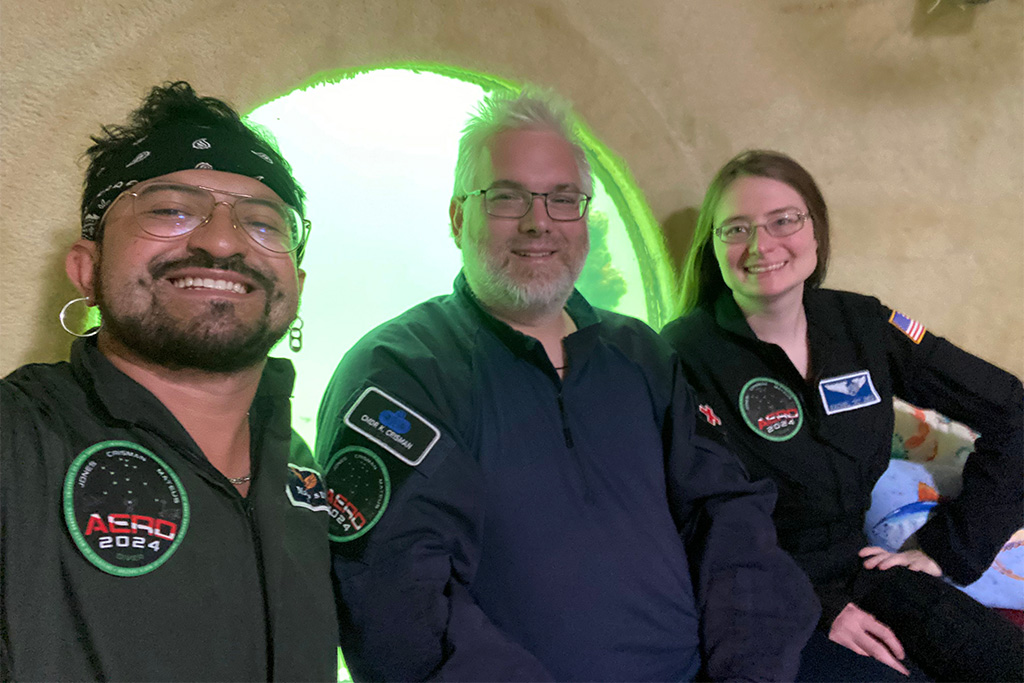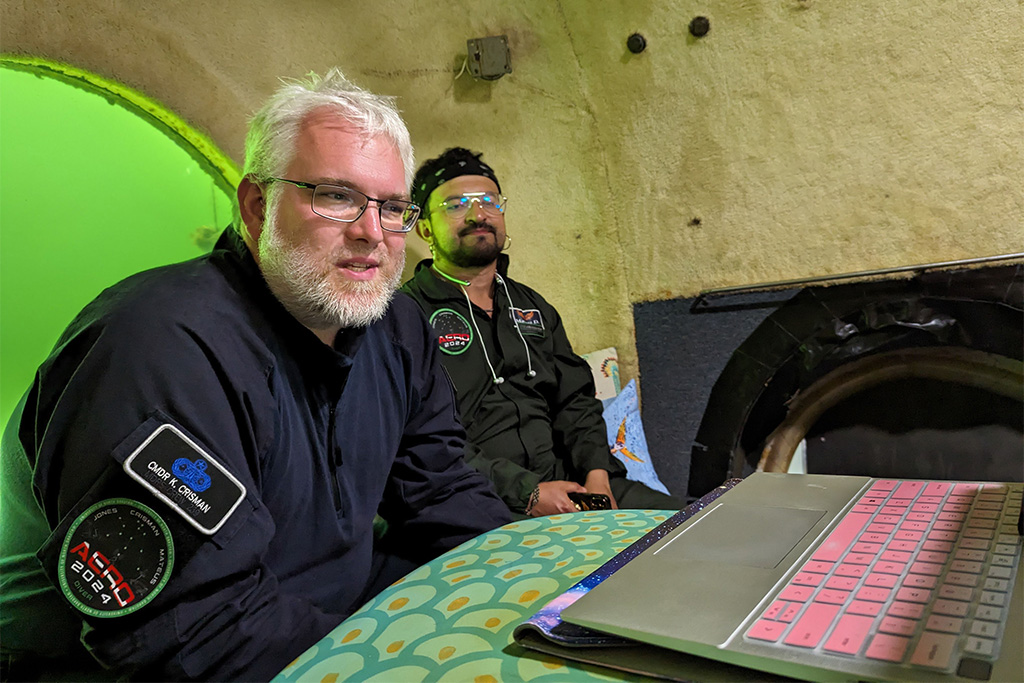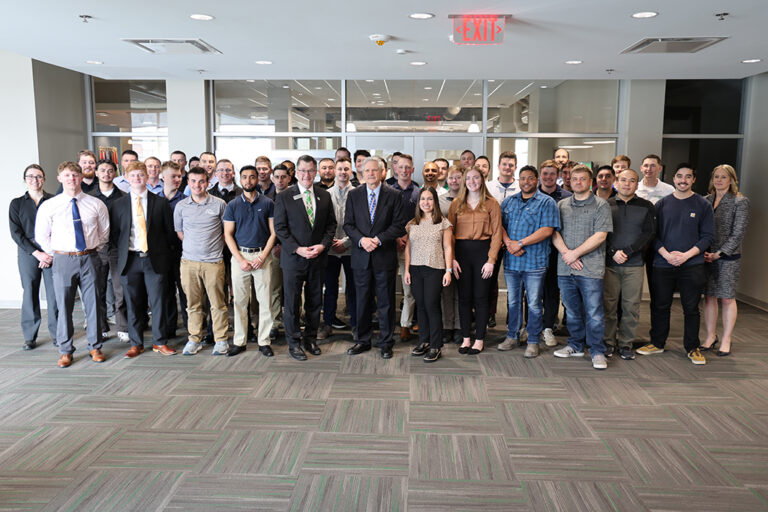Space studies, under the sea
Three UND researchers spent a day in an underwater habitat near Key Largo, Fla., to learn more about space

Editor’s note: In the UND LEADS Strategic Plan, the Discovery core value calls on the University to “foster innovative teaching, applied learning and transformative research.” The story below spotlights one of the University’s latest efforts to do just that.
****
South Africa … Australia … New Zealand … Prince Edward Island …
Locations rang from the speaker of a ham radio 22 feet underwater early on Jan. 6. Rachel Jones, an aerospace sciences Ph.D. student at UND, was operating the radio, hoping to successfully complete the first-ever underwater ham radio call.
Hours before, UND’s AERO (Adventure Expedition Research and Outreach) team took their last breath of fresh air before strapping on their scuba gear and diving off the coast of Key Largo, Fla. Their destination was Jules’ Undersea Lodge, an underwater habitat about 22 feet below the ocean’s surface.
The AERO crew — which included Jones, Space studies graduate student David Mateus and assistant professor of space studies Keith Crisman — would stay at the “lodge” for 24 hours to explore the sea, undertake research and conduct outreach.
A deep dive into space studies
Crisman is no stranger to such surroundings. He’s stayed at terrestrial habitats such as the Mars Desert Research Station in Utah multiple times, and has worked with UND’s own Inflatable Lunar-Mars Analog Habitat (ILMAH). Even so, the underwater facility was a unique experience for him.
“Staying at Jules’, you’re in the mindset of being in a space station,” Crisman said. “We’re very reliant on our safety systems here. Anytime we go outside we have to wear special gear, or the outside world — the ocean, in this case — would get rid of us very quickly. So, we have to keep that in mind with anything we’re doing while we’re staying at the habitat.”
Rather than staying in a habitat that sits atop a grassy field, Crisman, Jones and Mateus were in an environment totally surrounded by water. And as Crisman mentioned, deep water — like space — is a hostile environment that requires specific safety gear to navigate.
Luckily, the trio are experienced scuba divers and took three exploratory dives during their stay. Crisman says that these dives are a good way to understand the challenges of designing shelters and tools for space.
“Being neutrally buoyant like we are in water, helps us understand what being in microgravity will be like,” he said. “When you’re underwater and try to grab something with a higher friction rate than you, you’re going to get pulled towards it and not the other way around.”
Parabolic flights can replicate this as well, but that experience only lasts seconds. Scuba diving, on the other hand, is limited only by the human body and safety equipment, making it ideal for someone with Crisman’s interests.
As an academic, Crisman said that being at the facility heightened his understanding of the psychological and physical effects of living in space, especially the precautions one must take before stepping out of the habitat, and the feeling of being so isolated from familiar spaces.
It’s a valuable experience, Crisman says, and he has a vision to offer it to students at UND. Through yearly capstone-like trips to places such as Jules’ or – in the future– an underwater habitat for astronaut training, students interested in space travel would have a leg up when looking for jobs in the competitive market.
“We’re right at the forefront of commercial space travel, kind of like what commercial aviation was a century ago,” he said. “I think it’d be really valuable for UND to have a program that prepared students for that.”

‘Rock stars’ of research
One of AERO’s primary goals was outreach. Through the facility’s internet connection, the trio connected with three fourth grade classes at Century Elementary in Grand Forks as well as Grand Forks (FORX) and Key Largo (K4FLK) amateur radio to talk about their experiences.
“Outreach lets people know what science is being done and makes them a part of the process,” he said. “The audience asks really good questions that sometimes we haven’t thought of or may even propose a method or idea that can facilitate further research.”
Crisman said that the crew was a hit with the elementary students, who asked great questions about sharks, space and underwater dining.
The crew also gave a virtual tour of the facility and talked about the sea life — includ baby barracudas and bioluminescent jellyfish — they were expecting to see on their dives.
“As soon as we started the video, the students were all waving and jumping around,” Crisman said. “It makes you feel like a rock star for a minute.”
This, Crisman said, is another reason that outreach was a part of their mission in traveling to Jules’. There’s no better way to make a group of scientists smile, than to invite them to talk with a class of excited 10-year-old students.
“Seeing people excited for research makes us happy,” he said. “We feel like we are truly doing something for the world, and that certainly makes us want to keep pushing.”

Jones tunes in from submerged shack
Between dives and Zoom calls, the crew had one more goal: to successfully achieve ham radio communication underwater, a first to the crew’s knowledge.
“When we’re off planet and away from Earth, we won’t have satellites to rely on to get information quickly across,” he said. “Amateur radio, or something close to it, is probably going to be what we use.”
Understanding how ham radios work underwater would have major implications for future off-planet research, Crisman said. In particular, it could help with research on “ocean worlds” — moons covered in thick ice with water underneath, like Saturn’s Titan and Jupiter’s Europa.
“The idea is that you’d be able to deploy a rover in the water and use a cable and radio waves to communicate with an antenna,” he said. “We were testing to prove that we can at least transmit radio from underwater to the surface.”
During the testing, Rachel Jones sent messages from a ham radio onboard Jules’. With the help of a 100-foot connection to shore, she was able to successfully send and receive messages from places as far away as South Africa.
Initially, they’d planned to use an antenna attached to an innertube, but the previous night’s rain had flooded the flotation device and shorted its coax cable. Crisman said he’s working to design a cone-shaped gimbal to give the floating antenna another shot.
They’ll have a chance to try this design out soon, said Crisman. He and Jones are looking for funding to take another plunge in 2025, this time for a two-day stay with a four-member crew.
Additionally, after chatting with someone who works with the History of Diving Museum 36 miles away from Jules’, they found an opening for more potential underwater ham radio research.
“They own a two-person submersible that’s rated to 800 feet, and a remote submersible that’s rated well beyond that. They’re willing to help us test the system in deeper waters,” he said.
Stay tuned, as it sounds like Crisman, Jones and their crew have a lot more underwater radio research on the way. In the meantime, check out the video below to experience one of AERO’s dives in first-person POV:
****
>> QUESTIONS OR COMMENTS about the UND LEADS Strategic Plan? Your thoughts are welcome! Please contact Angie Carpenter, UND’s director of Special Student Populations, and/or Ryan Zerr, associate vice president for Strategy & Implementation, the co-chairs of the UND LEADS Implementation Committee.
You also may offer your thoughts by visiting the UND LEADS Strategic Plan home page and clicking on the “Provide your feedback” link that you’ll find there.
Thank you for your support of the UND LEADS Strategic Plan!



